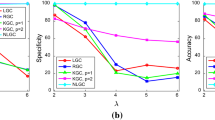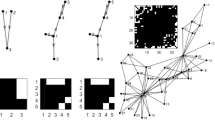Abstract
Neural information modeling and analysis often requires a measurement of the mutual influence among many signals. A common technique is the conditional Granger causality (cGC) which measures the influence of one time series on another time series in the presence of a third. Geweke has translated this condition into the frequency domain and has explored the mathematical relationships between the time and frequency domain expressions. Chen has observed that in practice, the expressions may return (meaningless) negative numbers, and has proposed an alternative which is based on a partitioned matrix scheme, which we call partitioned Granger causality (pGC). There has been some confusion in the literature about the relationship between cGC and pGC; some authors treat them as essentially identical measures, while others have noted that some properties (such as the relationship between the time and frequency domain expressions) do not hold for the pGC. This paper presents a series of matrix equalities that simplify the calculation of the pGC. In this simplified expression, the essential differences and similarities between the cGC and the pGC become clear; in essence, the pGC is dependent on only a subset of the parameters in the model estimation, and the noise residuals (which are uncorrelated in the cGC) need not be uncorrelated in the pGC. The mathematical results are illustrated with a simulation, and the measures are applied to an EEG dataset.







Similar content being viewed by others
References
Barnett L, Seth AK (2014) The MVGC multivariate Granger causality toolbox: a new approach to Granger-causal inference. J Neurosci Methods 223:50–68. doi:10.1016/j.jneumeth.2013.10.018
Barnett L, Barrett AB, Seth AK (2009) Granger causality and transfer entropy are equivalent for gaussian variables. Phys Rev Lett 103(23):238701
Bernasconi C, König P (1999) On the directionality of cortical interactions studied by structural analysis of electrophysiological recordings. Biol Cybern 81:199–210. doi:10.1007/s004220050556
Bollimunta A, Chen Y, Schroeder CE, Ding M (2008) Neuronal mechanisms of cortical alpha oscillations in awake-behaving macaques. J Neurosci 28(40):9976–9988
Bressler SL, Richter CG, Chen Y, Ding M (2007) Cortical functional network organization from autoregressive modeling of local field potential oscillations. Stat Med 26:3875–3885. doi:10.1002/sim.2935
Brovelli A (2012) Statistical analysis of single-trial granger causality spectra. Comput Math Methods Med. doi:10.1155/2012/697610
Chen Y, Bressler SL, Ding M (2006) Frequency decomposition of conditional Granger causality and application to multivariate neural field potential data. J Neurosci Methods 150(2): 228–237
Dhamala M, Rangarajan G, Ding M (2008) Analyzing information flow in brain networks with nonparametric Granger causality. Neuroimage 41(2):354–362
Geweke J (1984a) Inference and causality in economic time series. Handb Econom II:1102–1143
Geweke J (1984b) Measures of conditional linear dependence and feedback between time series. J Am Stat Assoc 79(388):907–915
Gourévitch B, Le Bouquin-Jeannès R, Faucon G (2006) Linear and nonlinear causality between signals: methods, examples and neurophysiological applications. Biol Cybern 95:349–369. doi:10.1007/s00422-006-0098-0
Granger CWJ (1969) Investigating causal relations by econometric models and cross-spectral methods. Econometrica 37(3):424–438
Kamiski M, Ding M, Truccolo WA, Bressler SL (2001) Evaluating causal relations in neural systems: Granger causality, directed transfer function and statistical assessment of significance. Biol Cybern 85:145–157. doi:10.1007/s004220000235
Kolman B, Hill DR (2008) Elementary linear algebra with application, 9th edn. Pearson Education, Pearson
Leung B, Cheung P, Riedner BA, Tononi G, Van Veen BD (2010) Estimation of cortical connectivity From EEG using state-space models. IEEE Trans Biomed Eng 57(9):2122–2134. http://ieeexplore.ieee.org/stamp/stamp.jsp?tp=&arnumber=5471144
Liao W, Mantini D, Zhang Z, Pan Z, Ding J, Gong Q, Yang Y, Chen H (2010) Evaluating the effective connectivity of resting state networks using conditional Granger causality. Biol Cybern 102(1):57–69
Malekpour S, Li Z, Cheung BLP, Castillo EM, Papanicolaou AC, Kramer LA, Fletcher JM, Van Veen BD (2012) Interhemispheric effective and functional cortical connectivity signatures of spina bifida are consistent with callosal anomaly. Brain Connect 2(3):142–154
Omidvarnia A (2011) Time-varying EEG connectivity: a time-frequency approach. http://www.mathworks.com/matlabcentral/fileexchange/33721-time-varying-eeg-connectivity-a-time-frequency-approach/content/WOSSPA_Mathworks_v2/mvar.m. Accessed Oct 2015
Omidvarnia A, Mesbah M, O’Toole JM, Colditz P, Boashash B (2011) Analysis of the time-varying cortical neural connectivity in the newborn EEG: a time-frequency approach. In: 7th international workshop on systems, signal processing and their applications (WoSSPA 2011), Tipaza. IEEE, pp 179–182. doi:10.1109/WOSSPA.2011.5931445
Schelter B, Winterhalder M, Timmer J (2006) Handbook of time series analysis. Wiley-VCH, Weinheim. doi:10.1002/9783527609970
Wang X, Chen Y, Bressler SL, Ding M (2007) Granger causality between multiple interdependent neurobiological time series: blockwise versus pairwise methods. Int J Neural Syst 17(2):71–78. doi:10.1142/S0129065707000944
Zhang F (2011) Matrix theory basic results and techniques, 2nd edn. Springer, New York
Zhou Z, Chen Y, Ding M, Wright P, Lu Z, Liu Y (2009) Analyzing brain networks with PCA and conditional granger causality. Hum Brain Mapp 30:2197–2206. doi:10.1002/hbm.20661
Author information
Authors and Affiliations
Corresponding author
Appendices
Appendix 1: Proof of Lemma 1
Proof
Equation (13) holds because
\(\square \)
Appendix 2: Proof of Lemma 2
Proof
X(f) and Y(f) calculated from (26) are equal to X(f) and Y(f) calculated from (25).\(\square \)
Appendix 3: Proof of Lemma 3
Proof
If \(k=n\), then an invertible matrix \(\mathbf B (f)\) can be chosen; hence, \(\mathbf A (f)\mathbf B (f)\mathbf B ^{-1}(f)=\mathbf C (f)\mathbf B (f)\mathbf B ^{-1}(f)\). Therefore, \(\mathbf A (f)=\mathbf C (f)\) (Kolman and Hill 2008).
However, if \(k\ne n\), then we can define \(\mathbf B _{i,j}(f)\) whose elements are zero except for one element in row i and column j, which is one. In that case, \(\mathbf A (f)\mathbf B _{i,j}(f)=\mathbf C (f)\mathbf B _{i,j}(f)\). Therefore, the ith column of \(\mathbf A (f)\) equals the ith column of \(\mathbf C (f)\). Since this holds for all \(i \in \{ 1,\dots , n \}, \mathbf A (f)=\mathbf C (f)\).\(\square \)
Appendix 4: Proof of Lemma 4
Proof
Since \((\mathbf AB )^{-1}=\mathbf B ^{-1}\mathbf A ^{-1}\), (21) can be rewritten as
Express the inverse \(\left( {\begin{array}{cc} \mathbf H _{\textit{XX}}(f) &{}\quad \mathbf H _{\textit{XZ}}(f) \\ \mathbf H _{\textit{ZX}}(f) &{}\quad \mathbf H _{\textit{ZZ}}(f) \\ \end{array}} \right) ^{-1}\) in form as \(\left( \begin{array}{cc} \mathbf L (f) &{}\quad \mathbf M (f) \\ \mathbf N (f) &{}\quad \mathbf K (f) \\ \end{array} \right) \), then
Moreover, according to (13) in Lemma 1
Using (24), where \(\mathbf Q (f)=\mathbf G (f) \mathbf H (f)\)
So, \(\mathbf Q _{\textit{XX}}(f)=\mathbf L (f)\mathbf H _{\textit{XX}}(f)+\mathbf M (f)\mathbf H _{\textit{ZX}}(f)\). On the other hand, since the matrix \(\left( \begin{array}{cc} \mathbf L (f) &{}\quad \mathbf M (f) \\ \mathbf N (f) &{}\quad \mathbf K (f) \\ \end{array} \right) \) is the inverse of \(\left( {\begin{array}{cc} \mathbf H _{\textit{XX}}(f) &{}\quad \mathbf H _{\textit{XZ}}(f) \\ \mathbf H _{\textit{ZX}}(f) &{}\quad \mathbf H _{\textit{ZZ}}(f) \\ \end{array}} \right) \), then
Therefore, \(\mathbf L (f)\mathbf H _{\textit{XX}}(f)+\mathbf M (f)\mathbf H _{\textit{ZX}}(f)=\mathbf I \), and consequently \(\mathbf Q _{\textit{XX}}(f)=\mathbf I \).\(\square \)
Appendix 5: Proof of Lemma 5
Proof
According to (37),
on the other hand from (38), it can be seen that \(\mathbf L (f)\mathbf H _{\textit{XZ}}(f)+\mathbf M (f)\mathbf H _{\textit{ZZ}}(f)=\mathbf 0 \); therefore, \(\mathbf Q _{\textit{XZ}}(f)=\mathbf 0 \).\(\square \)
Appendix 6: Proof of Lemma 6
Proof
Given (37), \(\mathbf Q _{\textit{XY}}(f)=\mathbf L (f)\mathbf H _{\textit{XY}}(f)+\mathbf M (f)\mathbf H _{\textit{ZY}}(f)\). Moreover, by using (38), \(\bar{E}_X(f)\) in (23), i.e.,
can be written as
So, \(\bar{E}_X(f)=E_X(f)+\mathbf Q _{\textit{XY}}(f)E_Y(f)\), where \(\mathbf Q _{\textit{XY}}(f)\) has been calculated in (37). Based on Lemma 2, (22) can be written as
where based on (41), \(\left( \begin{array}{c} \bar{E}_X(f)\\ 0 \\ \bar{E}_Z(f) \end{array}\right) \) is
or
Equation (43) holds because, after substituting it into (42), X(f) and Z(f) must satisfy (22). \(\gamma (f)\) should be defined such that
On the other hand as \(\mathbf H ^{-1}(f)=\mathbf A (f)\), so
So, by adding \(\mathbf A _{\textit{YY}}(f)\mathbf H _{\textit{YY}}(f)\) to both sides of (45)
By substituting (46) into (47)
Therefore,
Replacing (49) into (44) gives
The equation for \(\bar{E}_{X}(f)\) from (50) can be simplified as
On the other hand, based on (41), \(\bar{E}_X(f)=E_X(f)+\mathbf Q _{\textit{XY}}(f)E_Y(f)\) for all \(E_Y(f)\), so based on Lemma 3, \(\mathbf Q _{\textit{XY}}(f)=-\mathbf A _{\textit{XY}}(f)\mathbf A _{\textit{YY}}^{-1}(f)\) .\(\square \)
Appendix 7: Proof of Theorem 1
Proof
Based on Lemmas 4–6, the equation for conditional Granger causality, i.e., (17), can be simplified as follows
\(\square \)
Rights and permissions
About this article
Cite this article
Malekpour, S., Sethares, W.A. Conditional Granger causality and partitioned Granger causality: differences and similarities. Biol Cybern 109, 627–637 (2015). https://doi.org/10.1007/s00422-015-0665-3
Received:
Accepted:
Published:
Issue Date:
DOI: https://doi.org/10.1007/s00422-015-0665-3




